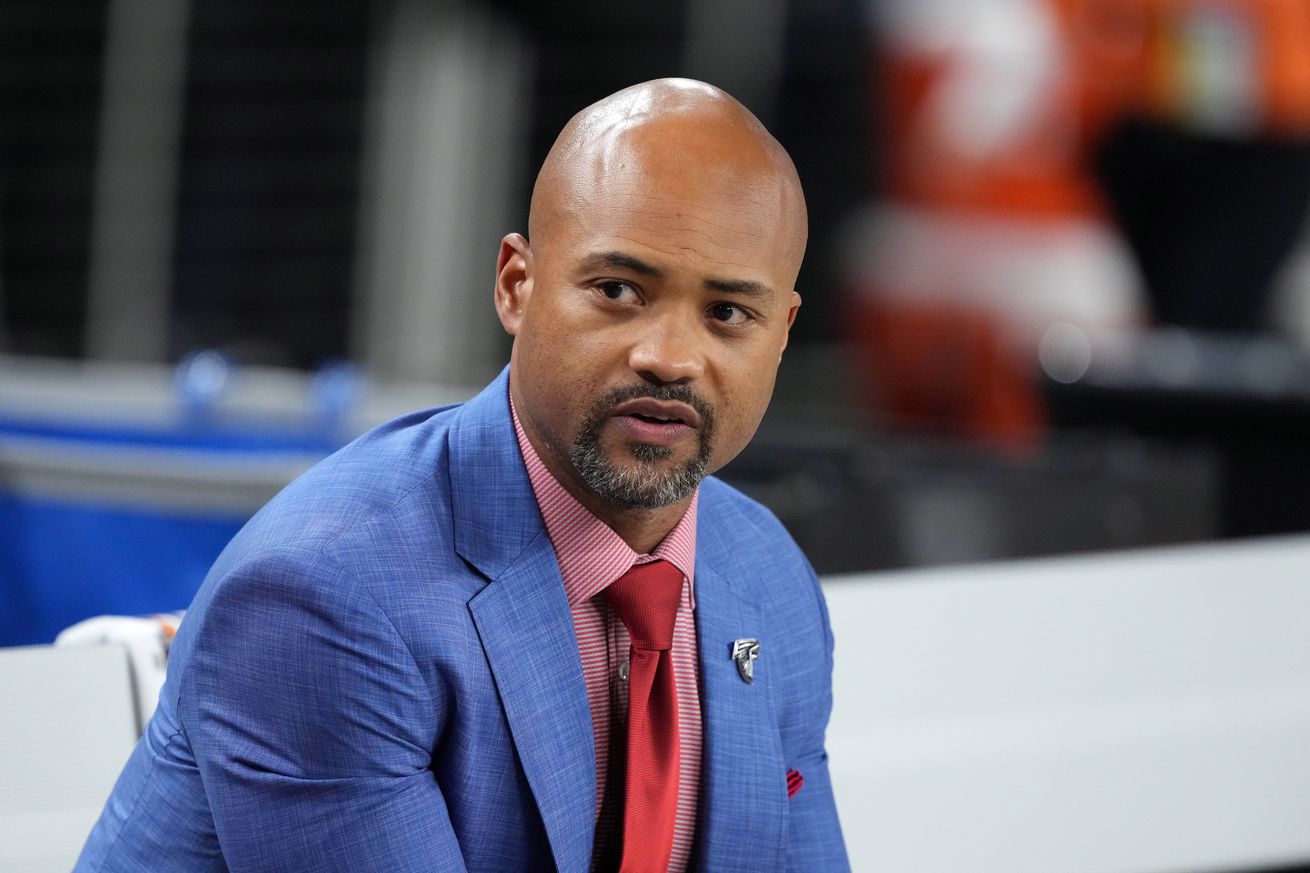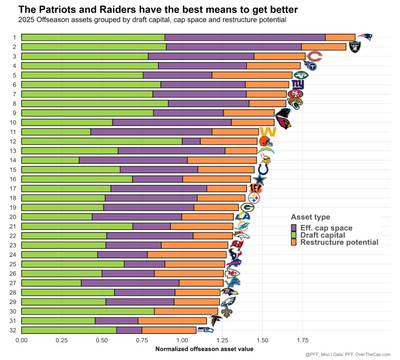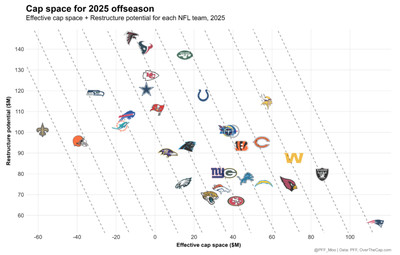
The Falcons will have to walk a tightrope to contend in 2025 without imperiling their future.
Draft season is in full swing, and teams are formulating their next course of action and prioritizing how to maximize their assets. Few teams are working with thinner margins than the Atlanta Falcons.
By the numbers
PFF has calculated the relative value of teams’ cap situations (effective cap space + restructure potential) and draft capital (pick value is based on the PFF WAR a player drafted at that pick generates on average during his first four years in the league). The numbers do not look good post-crunch.

@PFF_Moo | Data: PFF, OverTheCap.com
Atlanta’s total offseason asset value is ranked 31st, below the New Orleans Saints, who both PFF and OverTheCap show have no effective cap space to work with. This will be the defining offseason for Terry Fontenot’s career, culminating in the one that saves or buries him.
The Restructure onion
Atlanta’s cap situation is marginally better than its draft capital situation. Atlanta ranks 28th in effective cap space (-14,522,553). The team’s restructuring potential keeps the problem from being too grim, but it shouldn’t be treated or viewed as a get-out-of-jail-free card. Restructure potential is less valuable than effective cap space; PFF believes it’s worth half the value of true spending power (effective cap). This is because restructures come with strings attached; a team’s approach dictates how many.
There are simple restructures (converts payments into prorated signing bonuses within the confines of the remainder of the contract; teams can unilaterally execute simple restructures without any action necessary from the player typically) and maximum restructures (increases the cap space via conversion into prorated signing bonuses by extending the contract or adding void years, which serve only as placeholders for proration; these typically require player consent as they are considered contract renegotiations).
Atlanta’s potential value that can be opened via simple restructures is $63,392,097 (13th most), resulting in an effective cap space of $48,839,544 (29th most). The potential value that can be created via maximum restructures is $146,037,254 (1st most), resulting in an effective cap space of $131,484,701 (14th most).
While some see the potential dollar signs as a green light for spending, in reality, the team is staring down a yellow that could flash red at a moment’s notice. Hitting the gas could result in a life-altering mistake. It’s important to note that an extremely unlikely Kirk Cousins simple restructure is valued at $17,496,667, 27.6% of the potential total simple restructure value.

@PFF_Moo | Data: PFF, OverTheCap.com
Theory meets practice
Restructures are great in theory, but application and context are essential to consider before utilizing every possible cap mechanism. Teams with legitimate windows can risk future spending opportunities because their roster is sufficient and only needs a handful of immediate impact pieces. Restructure potential is used to get better or maintain stability for the upcoming season at the cost of having less cap maneuverability down the road.
In contrast, draft capital and effective cap space are used to acquire developmental talent and construct a better team over the next several years. The assets have crossover ability (trading picks for developed players), but generally, the assets are utilized as previously defined.
All these figures and stipulations are why Fontenot will have to work harder than ever to maximize the team’s outcomes. Going on a maximum restructure spree wouldn’t line up with the team’s roster, and it would also trap them in later years when the team will have to start constructing a Penix extension. New Orleans is trapped in a cycle of restructures due to their abuse of maximum restrutures. A slew of simple restructures, while better for the health of the cap long term, would lead to uninspiring roster concessions and retreads at a time when the team needs to upgrade its talent desperately.
The front office will have to toe the line and carefully utilize both. A simple restructure of Darnell Mooney could net the team $3,915,000, and a maximum restructure of Grady Jarrett could net the team $11,996,000. Remember, though, that Fontenot could only pull off the simple restructure without consulting his players. Jarrett would have to agree to his restructuring, as it would be viewed as an extension, with his money being distributed via void years, highlighting how multilayered and complicated the situation is.
To cut or not to cut
We haven’t discussed or measured the value created via cuts, an important variable in the cap equation. Cuts are an easy way to create cap space, but things can get complicated quickly. Take the contract of David Oneymata, for example. Teams are given two options with cuts, a pre-June 1st or post-June 1st designation. In Oneymata’s case, a pre-June 1st cut would save the team $8,075,000, while a post-June 1st cut would save the team $10,500,000. It seems like a simple decision: do a post-June 1st cut, but there’s more to it.
The team couldn’t use any of that $10.5M until June 2nd and must carry the current cap charge until then, making it irrelevant and an obstacle for the bulk of the free agency period. It would help the team during the rookie signing period and allow them to become cap compliant as they fill out the final roster heading into camp–there lies the benefit. If the team wants to get aggressive in free agency, they might view getting out early worth the $2M loss in savings, or they could look elsewhere for immediate gains and hold onto the player.
Teams can also designate a player at the start of the new league year (March 12th) as a post-June 1st cut. The team still has to carry the cap charge till June 1st, but they can avoid any incurring bonuses that kick in during the first week of the new league year and thereafter. The player can also enter the market early versus summer. David Oneymata is ineligible for such a designation as his contract was altered in 2024, a safeguard to prevent teams from gaming the system.
That said, someone like Kirk Cousins would be an ideal candidate for a designated post-June 1st cut due to the $10M bonus he is promised if he is still on the roster by March 17th. The team could avoid that bonus by making the early designation, and the difference in dead cap between that and a pre-June 1st trade is $2.5M.
With cuts, teams lose control over players they might want to re-sign for lower value in those scenarios and risk losing talent they would’ve preferred to come to a deal with. Another drawback with outright cutting is that whatever goes out must come back in, and as we’ve discussed, Atlanta is strapped for assets.
Draft capital
The Falcons hold five draft picks in the following rounds: 1st, 2nd, 4th, 7th, and 7th. The 3rd-round pick for Matthew Judon looks terrible in hindsight, but the process had merit. The player hitting a wall (rapidly accelerated by his defensive coordinator) was always the risk in the calculation. Yes, it’s a disappointing result, but it was a real swing compared to the vague “we tried to sign so and so” communications distributed in prior situations.
The 5th-round pick lost for tampering, and the 6th-round pick for Van Jefferson sting during a draft cycle boasting defensive line depth–a year removed from the Falcons trading away assets to acquire such a player.
Trade-down hoopla has been in motion since Fontenot’s final regular season presser, where he openly discussed the idea as a means to acquire more draft capital. It’s unlikely that was a bluff based on the evidence before us. If Fontenot believes that’s the best course forward, then fine, but as we’ve discussed, an action requires a reaction, and he’ll need to have his ducks in a row elsewhere instead of loading the proverbial basket with all of his eggs. It will take multiple quality draft picks and free agent acquisitions to boost Atlanta’s hopes at a successful 2025 and future.
No single free agent or draft pick can push this team over the hill. Good team building requires time and diversification. Atlanta hopes its 2024 trench investments pay off in 2025 while betting on its ability to draft and sign impact talent. If they fail to complete the job, their odds of success will take a considerable hit.
The combine and free agency are only a few weeks away, and the process of building an improved roster will finally begin. Terry Fontenot and the front office must be efficient with talent acquisition and hit on draft picks like never before. The path toward success exists; it will be on this regime to successfully navigate it.
